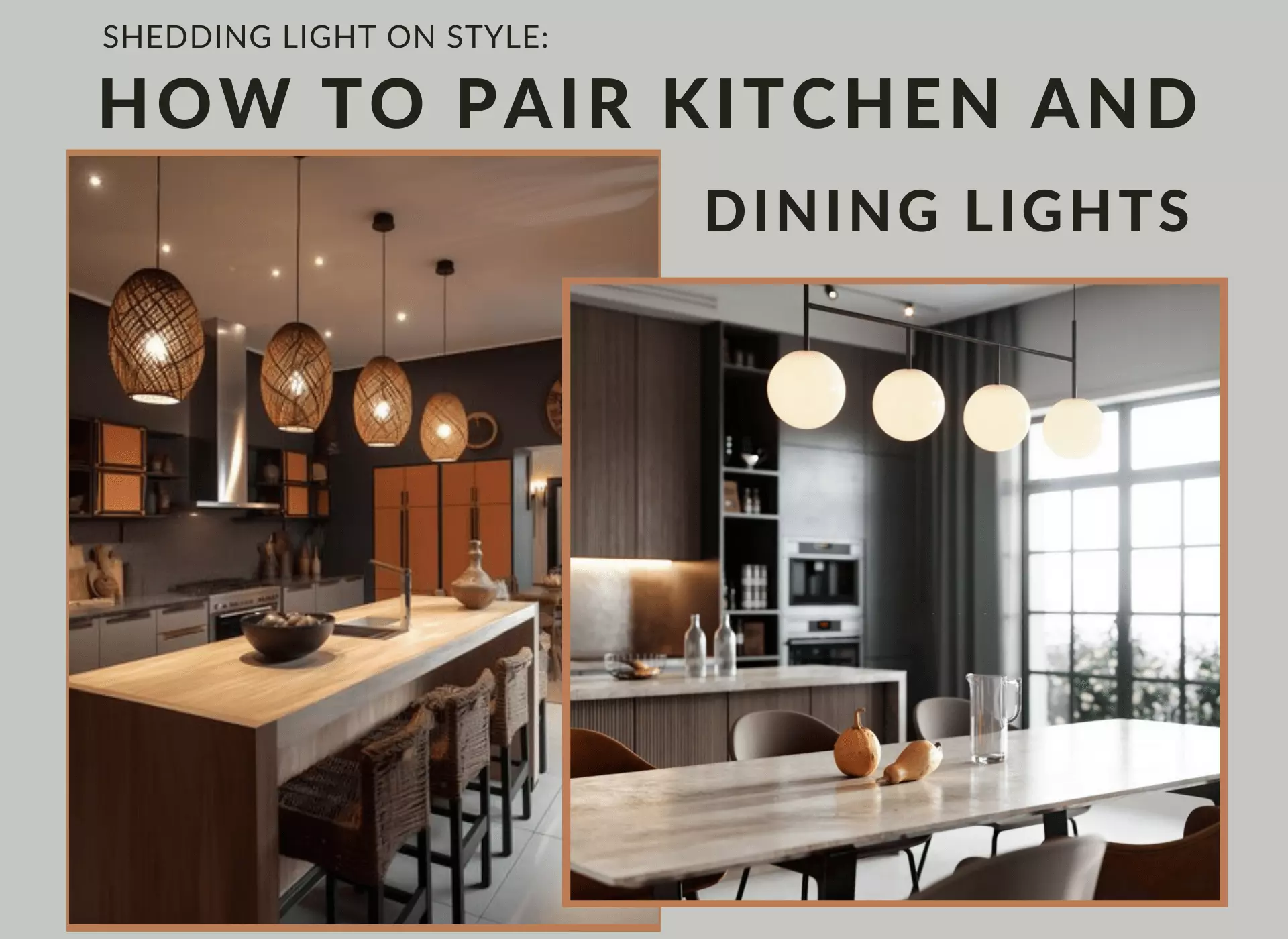You want to add a lavish look to your space and confuse how to pair kitchen and dining lights? It has an important influence on the ambiance of your home. The perfect combination of lights will transform your space into a harmonious blend of functionality and aesthetics. Oftentimes, lighting is the hidden hero of interior design.
In this guide, we will explore the technique of aligning kitchen and dining room lighting so that the space reflects elegance and warmth.
Understand Basics of Lighting
There are three types of lightning: ambient, task, and accent lighting. Each serves a distinct purpose, contributing to the overall ambiance and usability of the space.
Multiple Fixtures of Lights in Kitchen

Ambient Lighting: In a kitchen and dining area, ambient lighting can be achieved through ceiling-mounted fixtures, such as recessed lights or pendant lights.
Task Lightning: In the kitchen, task lighting is useful for areas like the countertops and the cooking stove. Under-cabinet lighting or pendant lights above the kitchen island are common choices. In the dining area, task lighting is crucial over the dining table, ensuring visibility for meals and other activities.
Accent Lightning: It can be used to showcase architectural elements, artwork, or even certain features in the kitchen, like a decorative backsplash. In the dining area, accent lighting can be applied to highlight a buffet, sideboard, or a piece of art on the wall.
Pendant Lighting: Enhance your kitchen and dining area with pendant lighting, a versatile option regardless of the room’s design. Pendant lights offer an elegant and functional lighting solution for any space, with a variety of in-store and online options.
Chandelier Lighting: Consider crystal chandelier lighting for an added touch of radiance and sophistication. Ideal for kitchens and dining rooms, they contribute a rich and lively atmosphere.
Ensure that your ceilings are high enough to accommodate these magnificent lighting fixtures, which are ideal for homes with a traditional aesthetic.
How Do You Choose Chandelier Lights ?

Choose a chandelier by considering the room’s size, style, and purpose. Ensure the fixture complements the overall design, fits the space appropriately, and provides adequate illumination for the intended function.
Chandelier And Pendant Combinations

It should complement each other in style and finish, creating a cohesive look while providing balanced illumination in a room.
How To Navigate The Vast World Of Lighting Fixtures And Get The Perfect One ?

You will be confused after exploring types and how to coordinate all of them well to see optimal and premium ambiance.
So there are the factors to consider when you are planning on pairing kitchen and dining lights.
Factors To Consider When Selecting Kitchen Lighting
Decide On Focal Point
Choose a standout feature, considering function, visual weight, personal taste, and balance, to create a captivating focal point in your space.
It should not be like you install all the light nearby, create a well-rounded lightning scheme with kitchen and dining lights.
Coordinating With Kitchen Design And Color Schemes

After deciding on focal points , select lights according to the theme and colors of your kitchen.
Like if you have black theme kitchen, consider Light-color light and bright so that they come up as sole pairing. And if you have white theme kitchen, go for dark-color and warm lights to make it sensational.
Illuminating The Island And Dining Room

Lighting coordination between the island and dining room is one of the most important issues to consider. Picking compatible styles ensures a unified aesthetic and forms a unified design storyline that links these spaces.
Dimmer Controls

Opt for dimmable fixtures to adjust lighting levels based on tasks, mood, or time of day, offering flexibility and energy efficiency.
Proportion Is Crucial
Ensure that the size of your lightning is proportional to the space available.The scale of your kitchen island or dining area should correspond with the size of your overhead lightning.
Consider the size of your dining area when selecting lights. For smaller spaces, opt for sleek and minimalistic fixtures, while larger areas can accommodate more ornate and elaborate designs.
Ceiling Height
Consider the height of your ceilings when choosing fixtures, ensuring they complement the room’s proportions without overwhelming the space.
Overhead vs. Task Lighting
Strike a balance between overhead lighting for ambient illumination and task lighting for functional purposes. This dynamic duo ensures a well-lit space that meets both aesthetic and practical needs.
Color Temperature
Select bulbs with the right color temperature (measured in Kelvins) to achieve the desired warmth or coolness in the kitchen, influencing the overall atmosphere.
Style and Aesthetics

Harmonizing the design of lighting fixtures with the overall aesthetic of your kitchen whether it’s, mordern, traditional, or electric vibe to create a cohesive look.
You can go for minimalist pendant lights with clean lines and geometric shapes with metallic fixtures. For traditional, select timeless chandelier with ornate details with warm fixtures.
Multiple pendant lights with classic designs can also complement the overall theme.
Lighting Fixtures

Coordinate by considering their style, finish, and placement. Ensure a cohesive design that enhances the overall aesthetic while meeting functional lighting needs.
Should Light Fixtures Match Kitchen Hardware?
Light fixtures don’t need to match kitchen hardware precisely. Coordinating finishes or styles can create a harmonious look, but mixing can add visual interest if done thoughtfully.
Maintenance and Cleaning
Choose fixtures that are easy to clean and maintain, especially in a space prone to grease and cooking residues. This ensures longevity and sustained performance.
Don’ts:
- Dont over crowd
- Dont Clash with colours
- Avoid Disproportionate Sizing
- Don’t Neglect Task Lighting
- Don’t Overlook Maintenance
- Don’t Underestimate Installation Complexity
- Don’t Neglect Natural Lighting
- Don’t Overdo Ornamentation
- Don’t Ignore Future Changes
Conclusion:
When functionality and elegance operate in the context of interior design, chemistry occurs. Mastering the art of coordinating kitchen and dining room lighting enhances the overall ambiance of your home.
Whether you prefer a cohesive look or an eclectic mix, the key is to strike a balance between style and functionality. Illuminate your spaces with confidence and let your personality shine through with a sprinkling of imagination which creates all design and helps to implement.
FAQs
1. Do All The Light Fixtures In My Kitchen And Dining Room Need To Match?
Not necessarily. While matching creates a unified look, mixing styles can add character and interest.
2. How Can I Coordinate Lighting Between My Kitchen Island And Dining Area?
Use complementary fixtures or choose a common design element to tie the spaces together visually.
3. Is It Okay To Mix Modern And Traditional Lighting Styles?
Absolutely. Blending modern and traditional styles can result in a timeless and balanced aesthetic.
4. Should Light Fixtures Match My Kitchen Hardware?
It’s a matter of personal preference. Matching creates cohesion, while mixing adds an eclectic touch.
5. What’s The Importance Of Specific Lighting Choices In Creating Ambiance?
Specific lighting choices allow you to tailor the ambiance of each space to suit your desired mood.
6. How Do You Pair Light Fixtures?
Pair light fixtures by considering their style, size, and purpose. Ensure a cohesive design throughout your space, using fixtures that complement each other in terms of aesthetics and functionality.
7. What Is The Role Of Pendant Lights On The Dining Table?
Pendant lights above a dining table work for both functional and aesthetic purposes. They provide focused illumination for dining tasks also contributing to the overall ambiance and style of the dining area.
If you want to need more information about home so please visit our more amazing blogs: HomeSpecialize





